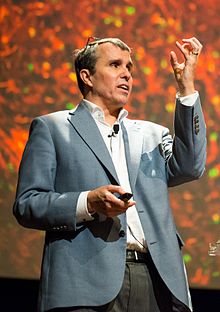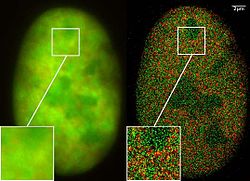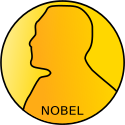Eric Betzig
| Eric Betzig | |
| Född | 13 januari 1960 Ann Arbor, Michigan, USA |
|---|---|
| Nationalitet | Amerikan |
| Forskningsområde | Tillämpad fysik |
| Institutioner | Howard Hughes Medical Institute |
| Alma mater | California Institute of Technology, Caltech Cornell University |
| ORCID | 0000-0002-4192-1274 |
| Känd för | Nanoskopi, fluorescensmikroskopi |
| Nämnvärda priser | William L. McMillan Award (1992) National Academy of Sciences Award for Initiatives in Research (1993)[1] Nobelpriset i kemi (2014) |
Robert Eric Betzig,[2] född 13 januari 1960 i Ann Arbor i Michigan,[3] är en amerikansk fysiker. 2014 tilldelades han Nobelpriset i kemi tillsammans med Stefan Hell och William Moerner "för utveckling av superupplöst fluorescensmikroskopi".
Betzig blev filosofie doktor 1988 vid Cornell University i Ithaca. Han är gruppledare vid Janelia Farm Research Campus vid Howard Hughes Medical Institute i Ashburn, Virginia[4][5]
Referenser
- ^ ”Eric Betzig”. janelia.org. Janelia Farm Research Campus. http://www.janelia.org/people/scientist/eric-betzig. Läst 11 oktober 2014.
- ^ ”Eighty-Ninth Annual Commencement – California Institute of Technology”. California Institute of Technology. 10 juni 1983. http://caltechcampuspubs.library.caltech.edu/2491/1/June_10,_1983.pdf. Läst 11 oktober 2014.
- ^ ”Eric Betzig, PhD”. Howard Hughes Medical Institute. http://www.hhmi.org/scientists/eric-betzig. Läst 11 oktober 2014.
- ^ Kungliga Vetenskapsakademien (8 oktober 2014). ”Nobelpriset i kemi 2014”. Pressmeddelande. Läst 11 oktober 2014.
- ^ ”The Nobel Prize in Chemistry 2014 - Surpassing the limitations of the light microscope”. Nobelprize.org. Nobel Media AB. 8 oktober 2014. http://www.nobelprize.org/nobel_prizes/chemistry/laureates/2014/press.html. Läst 11 oktober 2014.
| |||||||||||||||||||
|
Media som används på denna webbplats
Författare/Upphovsman: User:Gusme (it:Utente:Gusme), Licens: CC BY-SA 3.0
Vector image of the Nobel prize medal
Författare/Upphovsman: Andy Nestl, Licens: CC BY-SA 3.0
GFP superresolution, optical nanoscopy ( Christoph Cremer, emeritus at Heidelberg university [1])
View of a nucleus of a bone cancer cell: using normal high resolution fluorescence microscopy, it is not possible to distinguish details of its structure (image on the left). Using the two Color Localization Microscopy 2CLM (image on the right) it is possible to localize 70,000 histone molecules (red: RFP-H2A) and 50,000 chromatin remodeling proteins (green: GPF-Snf2H) in a field of view of 470 µm2 with an optical depth of 600 nm. Common fluorescence markers were used.
2CLM is the only optical nanoscopy method that allows position based co-localization of single molecules at high density in a wide field of view using conventional fluorescent proteins such as GFP, YFP, RFP, or other conventional fluorochromes.
Due to its high optical single molecule resolution, 2CLM allows significantly more precise analyses of potential protein interactions than FRET-(Fluorescence Resonance Energy Transfer) technology, which is at present the preferred method for such investigations. This is of particular significance in studies of biomolecular machines (BMMs) within cells: Single BMMS can be analysed, including the number of molecules of a given type; distances between proteins in these BMMs often are substantially greater than those that can be analyzed by FRET (restricted to a maximum distance of only a few nm).
Possible to use conventional, well established and inexpensive fluorescent dyes, from the GFP group, and its dye variants, to the well-known Alexa and fluorescein dyes. Fundamental to SPDMphymod are blinking phenomena (flashes of fluorescence), induced by reversible bleaches (metastable dark states). Individual molecules of the same spectral emission color can be detected.
Publikation: Manuel Gunkel, Fabian Erdel, Karsten Rippe, Paul Lemmer, Rainer Kaufmann, Christoph Hörmann, Roman Amberger and Christoph Cremer: Dual color localization microscopy of cellular nanostructures. In: Biotechnology Journal, 2009, 4, 927-938. ISSN 1860-6768Författare/Upphovsman: Ecole polytechnique Université Paris-Saclay, Licens: CC BY-SA 2.0
Eric Betzig , prix Nobel de chimie 2014, a donné une conférence à l’École polytechnique sur le thème de l’imagerie à haute résolution spatio-temporelle






